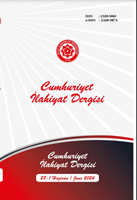Nahivde Sahâbî ve Tâbiî Kavlinin Hüccet Değeri
The Evidential of the Tradition of the Companions and Tābiʿī in Naḥw
Author(s): Mehmet Zahid ÇokyürürSubject(s): History of Islam, Sociology of Religion, History of Religion
Published by: Cumhuriyet Üniversitesi İlahyat Fakültesi
Keywords: Arabic Language and Rhetoric; Naḥw; İstishhād; Ḥadīth; Tradition of the Companions and Tābiʿī;
Summary/Abstract: In Arabic grammar, ḥadīt̲h̲is also included in the practice of istishhād, although not as much as the other narrative evidence. In some circles, only the words of the Prophet (pbuh) are understood when it comes to istishhād with hadīth in grammar. However, the concept of ḥadīt̲h̲is a broader content than this and includes the words of the Companions and the tābiʿī. When the views on istishhāda in the grammatical literature are reviewed, it is seen that not only the words of the Prophet but also the sayings of the Companions and even some of the tābiʿīn are taken as reference. Based on information, hypotheses such as the place of the sayings of the Companions and the tābiʿīn in the ḥadīt̲h̲s, who are the Companions and the tābiʿīn whose sayings are used in istishhād, and the quantitative and qualitative status of their effects on istishhād come on the agenda. On the other hand, the question of whether the sayings of the Companions and the tābiʿīn, some of whom were Arabs, can be considered within the ‘Arabic tradition’ is another strong question mark that comes to mind. Based on these assumptions, we have come to the conclusion that a conclusion can be reached in this research by pursuing the following objectives: 1-The relationship between the sayings of the Companions and the tābiʿīn and the Arabic dialect 2- The nature and limitations of the hadīth in the conceptual dimension 3- Determining the practice of theoretical discussions within the framework of istishhād with the hadīth, as well as the practice of istishhād with the sayings of the Companions and the tābiʿīs in the literature. 4- Determine the compatibility of theory and practice in the literature according to the data obtained. Accordingly, in the research, first of all, both in the early period and in the late period, istishhād. Under these headings, firstly, the general attitude of the relevant scholar in terms of istishhād with hadīth was briefly mentioned, and then both a remarkable example of istishhād with the companions‘ sayings was tried to be included and the qualitative and quantitative aspects of the attitudes of istishhād with the companions’ sayings were tried to be pointed out. The result of this research is that in the early period, grammar scholars such as al-Sībawayhi (d. 180/796), Yaḥyā b. Ziyād al-Farā (d. 207/822), al-Akhfash al-Awsaṭ (d. 215/830 [?]) and al-Mubarrī (d. 286/900) took the sayings of the leading names of the Companions such as Hazrat ‘Umar (d. 23/644) and Hazrat ʿAlī (d. 40/661), who were famous for their eloquence, as a basis, albeit to a lesser extent, and in the late period, Zamakhsharī (d. 538/1144) was the first to use the sayings of these two Companions. 538/1144), and in time, thanks to the famous scholars of the later period, especially ʿAbd al-Raḥmān b. ʿAbdallāh Suhaylī (d. 581/1185), Ibn Mālik al-Ṭāʾī (d. 672/1274), al-Raḍī al-Astarābādī (d. after 688/1289), Abū Ḥayyān al-Andalusī (d. 745/1344), and Ibn His̲h̲ām al-Naḥwī (d. 761/1360), more sahābī and tābiʿī jawls entered the grammatical literature. In the final analysis, it has been concluded that in practice, under the name of istishhād with hadīth, in addition to the words of the Prophet (pbuh) himself, some of the sayings of the Companions and the tābiʿīn are also included, and that these sayings are closer to the category of hadīth, although they have a place in the Arabic tradition. Again, in the late period, scholars such as Zamakhsharī, Ibn Ḥazm (d. 456/1064), Suhaylī, and Ibn Jarūf alIshbīlī (d. 609/1212), in addition to the sayings of the Prophet (s.a.s.) himself, also included the sayings of the Prophet (s.a.s.).
Journal: Cumhuriyet İlahiyat Dergisi
- Issue Year: 28/2024
- Issue No: 1
- Page Range: 160-179
- Page Count: 20
- Language: Turkish

